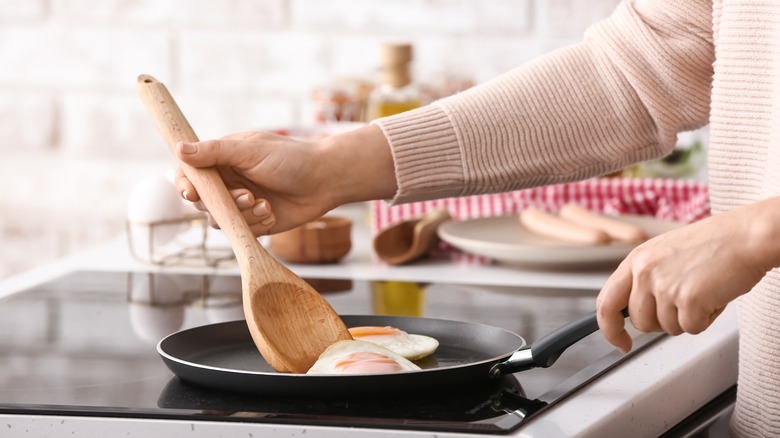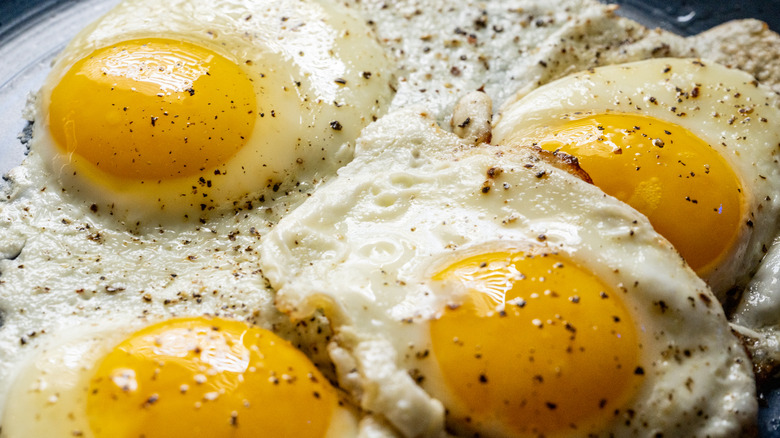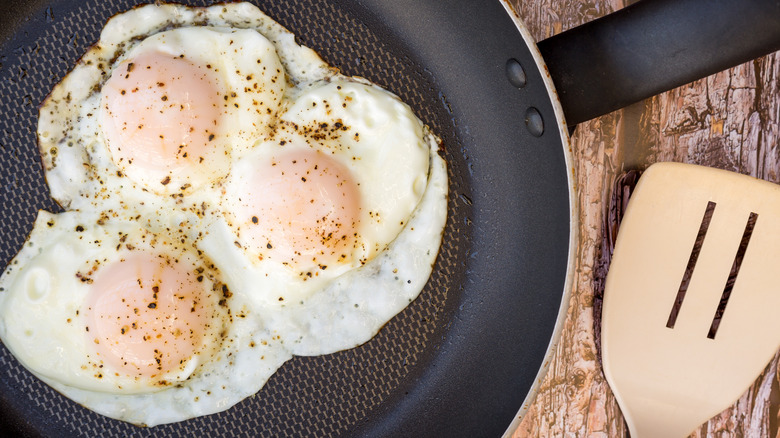The Difference Between A Sunny Side Up And Over-Easy Egg Is One Flip
Making an acceptable fried egg should be a part of your kitchen repertoire so you can add this tasty protein bump to your meals in a jiffy. Sure, it'll raise your breakfast game, but a fried egg can also upgrade a plethora of dishes — everything from sandwiches to ramen bowls. And, if you're one of those people who are particular about how they like their eggs done and coffee served in the morning, learning the nuances of the simplest egg recipes can help you truly understand how heat affects egg whites and yolks.
The sunny side up is a classic — its bulbous, shining liquid yellow yolk amidst glossy, just-set whites is the quintessential breakfast image. Aesthetically, an over-easy egg is on the other end of the spectrum, looking almost drab with a faint white film covering the entire surface. Cut into it, however, and that gorgeous yolk should spill out if the egg is properly done over easy (the "easy" refers to the barely cooked yolk).
It all comes down to flipping the egg — one dish requires it, and one doesn't. However, that flip (or lack thereof) also opens up potential stumbling blocks for both these dishes. A sunny side up isn't flipped, so cooking the whites on top requires some finesse. On the other hand, flipping over easy eggs without breaking the yolk requires dexterity and some practice. Here's how to get both these dishes right every time.
A sunny side up egg is NOT flipped
A good sunny side up is lightly browned from below, while the top of this egg never directly touches the pan, leaning on indirect heat to set the whites while keeping the yellow liquid. Always start with a well-seasoned cast iron skillet or a good nonstick pan and some fat. Cooking spray, butter, and bacon grease all work well and help fry the egg and slide it off the pan while maintaining its shape.
Let the egg cook for about three minutes on medium heat until the edges start curling. A sunny side up doesn't need to be moved around with a spatula until it's ready to be taken off the pan, at which point it can be carefully slid onto a plate.
You must balance the heat so that the white is thoroughly cooked while ensuring the yolk doesn't solidify. If you notice the whites looking a little slimy on the top, cover the pan for about half a minute to help cook them through. Another way to ensure cooked whites and liquid yolks is to cover your pan for the first minute and a half of cooking and then uncover it to finish frying the egg and crisping the bottom. Adding the lid provides gentle heat to the top of the egg, enough to set the white without cooking the yolk through.
An over easy egg IS flipped
For an over-easy egg, follow the initial steps of making a sunny side up — seasoned or non-stick pan, medium heat, and cooking fat. Since the egg is flipped, there is no need to cover it. Instead, focus on ensuring the pan's surface is well coated with the cooking fat and that the egg whites don't spread too far when you transfer the raw egg to the pan. This will make flipping it easier.
Cook the egg like a sunny side up for about three minutes, and then it's time for the big maneuver! Use a thin spatula and gently slide it under the egg, shaking the pan slightly if required. Don't worry if the egg whites are spread too far; focus on getting the spatula under the yolk. Make the flip in one smooth motion while being careful that the egg doesn't fall with too much force.
The top of the over-easy egg must cook for about 30 seconds — enough to form a thin cooked layer over the yolk while the rest remains fluid. If the yolk solidifies, you have an over-medium or over-hard egg instead. Once the egg is ready, be sure to serve it with the side that was cooked first facing down, meaning you must flip an over-easy egg a second time before sliding it off the pan and onto a plate.


